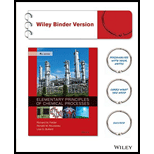
Gas absorption or gas scrubbing is a commonly used method for removing environmentally undesirable species from waste gases in chemical manufacturing and combustion processes. The waste gas is contacted with a liquid solvent in which the potential pollutants are soluble and the other species in the waste gas are relatively insoluble. Most of the pollutants go into solution and emerge with the liquid effluent from the scrubber, and the cleaned gas is discharged to the atmosphere. The liquid effluent may be sent to a waste lagoon or subjected to further treatment to recover the solvent and/or to convert the pollutant to a species that can be released safely to the environment.
A waste gas containing SO2 (a precursor of acid rain) and several other species (collectively designated as A) is fed to a scrubbing tower where it contacts a solvent (B) that absorbs SO2. The solvent feed rate to the tower is 1000 L/min. The specific gravity of the solvent is 1.30. Absorption of A and evaporation of B in the scrubber may be neglected.
Stream 3
The gas in the scrubber rises through a series of trays (metal plates perforated with many small holes), and the solvent flows over the trays and through downcomers to the trays below. Gas bubbles emerge from the holes in each tray and rise through the covering liquid, and SO2 transfers from the bubbles and into solution.
The volumetric flow rate of the feed gas is determined w ith an orifice meter, w ith a differential mercury manometer being used to measure the pressure drop across the orifice. Calibration data for the meter are tabulated here:
| /j(mm) | V(m3/min) |
| 1(X) | 142 |
| 200 | 204 |
| 300 | 247 |
| 400 | 290 |
The molar density of the feed gas may be determined from the formula
zmol\ _ 12.2P(atm)
' \fiter/ f(K)
where P and T are the absolute pressure and temperature of the gas. An electrochemical detector is used to measure the SO2 concentration in the inlet and outlet gas streams: SO2 in the sampled gas is absorbed in a solution across w hich a fixed voltage is applied, and the mole fraction of SO2 in the gas is determined from
the resulting current. The calibration curve for the analyzer is a straight line on a semilog plot of y (mol SCWmol total) versus R (analyzer reading) that passes through the following points:
| y (log scale) | R (rectangular scale) |
| 0.00166 | 20 |
| 0.1107 | 90 |
The following data are taken:
T = 75°F P = 150 psig
/i(orifice meter) = 210 mm /?(SO2 analyzer) = 82.4 /?(SO2 analyzer) = 11.6 (outlet gas)
- Draw' and completely label a process flowchart. Include in the labeling the molar flow' rates and SO2 mole fractions of the gas streams and the mass flow' rates and SO2 mass fractions of the liquid streams. Show' that the scrubber has zero degrees of freedom.
- Determine (i) the orifice meter calibration formula by plotting V versus h on logarithmic axes and (ii) the SO2 analyzer calibration formula.
Want to see the full answer?
Check out a sample textbook solution
Chapter 4 Solutions
Elementary Principles of Chemical Processes, Binder Ready Version
Additional Engineering Textbook Solutions
Elements of Chemical Reaction Engineering (5th Edition) (Prentice Hall International Series in the Physical and Chemical Engineering Sciences)
Process Dynamics and Control, 4e
Fox and McDonald's Introduction to Fluid Mechanics
Thinking Like an Engineer: An Active Learning Approach (4th Edition)
Structural Steel Design (6th Edition)
Starting Out with Python (3rd Edition)
 Introduction to Chemical Engineering Thermodynami...Chemical EngineeringISBN:9781259696527Author:J.M. Smith Termodinamica en ingenieria quimica, Hendrick C Van Ness, Michael Abbott, Mark SwihartPublisher:McGraw-Hill Education
Introduction to Chemical Engineering Thermodynami...Chemical EngineeringISBN:9781259696527Author:J.M. Smith Termodinamica en ingenieria quimica, Hendrick C Van Ness, Michael Abbott, Mark SwihartPublisher:McGraw-Hill Education Elementary Principles of Chemical Processes, Bind...Chemical EngineeringISBN:9781118431221Author:Richard M. Felder, Ronald W. Rousseau, Lisa G. BullardPublisher:WILEY
Elementary Principles of Chemical Processes, Bind...Chemical EngineeringISBN:9781118431221Author:Richard M. Felder, Ronald W. Rousseau, Lisa G. BullardPublisher:WILEY Elements of Chemical Reaction Engineering (5th Ed...Chemical EngineeringISBN:9780133887518Author:H. Scott FoglerPublisher:Prentice Hall
Elements of Chemical Reaction Engineering (5th Ed...Chemical EngineeringISBN:9780133887518Author:H. Scott FoglerPublisher:Prentice Hall
 Industrial Plastics: Theory and ApplicationsChemical EngineeringISBN:9781285061238Author:Lokensgard, ErikPublisher:Delmar Cengage Learning
Industrial Plastics: Theory and ApplicationsChemical EngineeringISBN:9781285061238Author:Lokensgard, ErikPublisher:Delmar Cengage Learning Unit Operations of Chemical EngineeringChemical EngineeringISBN:9780072848236Author:Warren McCabe, Julian C. Smith, Peter HarriottPublisher:McGraw-Hill Companies, The
Unit Operations of Chemical EngineeringChemical EngineeringISBN:9780072848236Author:Warren McCabe, Julian C. Smith, Peter HarriottPublisher:McGraw-Hill Companies, The





